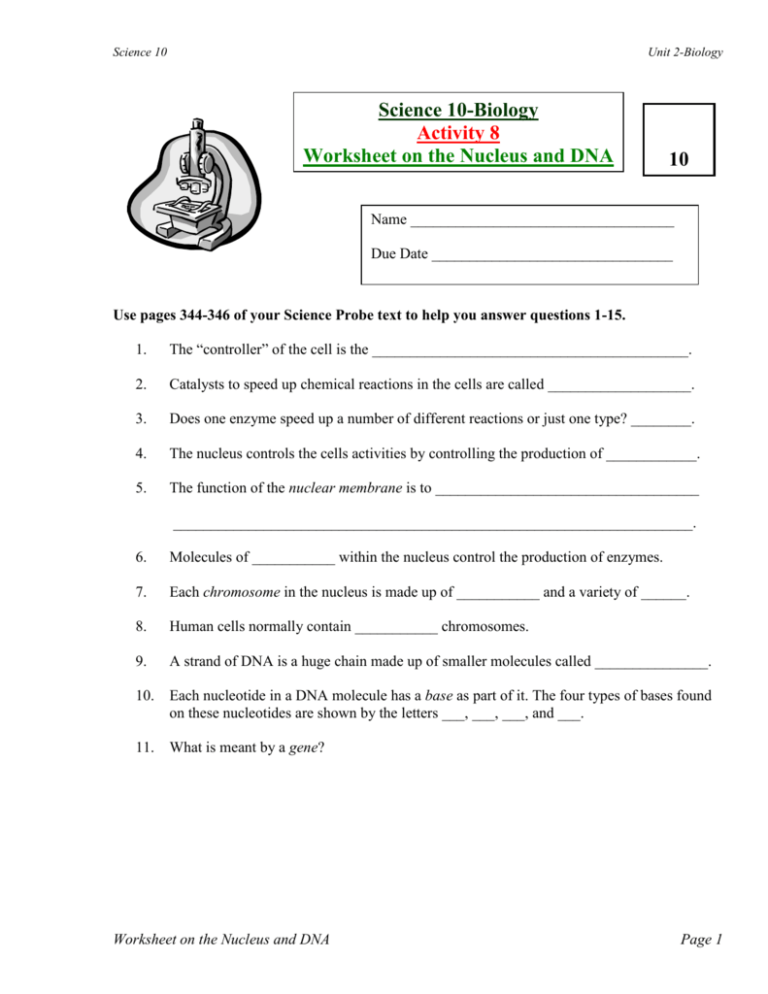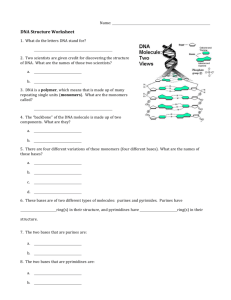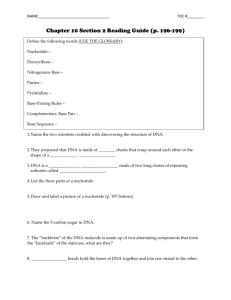Science 10
advertisement

Science 10 Unit 2-Biology Science 10-Biology Activity 8 Worksheet on the Nucleus and DNA 10 Name ___________________________________ Due Date ________________________________ Use pages 344-346 of your Science Probe text to help you answer questions 1-15. 1. The “controller” of the cell is the __________________________________________. 2. Catalysts to speed up chemical reactions in the cells are called ___________________. 3. Does one enzyme speed up a number of different reactions or just one type? ________. 4. The nucleus controls the cells activities by controlling the production of ____________. 5. The function of the nuclear membrane is to ___________________________________ _____________________________________________________________________. 6. Molecules of ___________ within the nucleus control the production of enzymes. 7. Each chromosome in the nucleus is made up of ___________ and a variety of ______. 8. Human cells normally contain ___________ chromosomes. 9. A strand of DNA is a huge chain made up of smaller molecules called _______________. 10. Each nucleotide in a DNA molecule has a base as part of it. The four types of bases found on these nucleotides are shown by the letters ___, ___, ___, and ___. 11. What is meant by a gene? Worksheet on the Nucleus and DNA Page 1 Science 10 Unit 2-Biology 12. Look at Figure 15.20 on the top of page 346. On the left of this diagram, DNA is shown as a ladder. The right and the left side of the ladder consists of long chains made up of “P”s and “S”s. Each “P” stands for a ________________ and each “S” stands for a ________. The bases are symbolized by the letters __, __, __ and __. 13. The actual DNA structure is not really like a ladder, but like two coils wrapped around each other. This structure is called a double ___________________. This structure was first discovered by two scientists ____________________ and ______________________. 14. The number and order (sequence) of bases on each gene determine the exact structure of the ___________________ “coded” by that gene. Each chromosome contains thousands of genes, each one controlling the structure of one protein or enzyme made by the cell. 15. What do you think could happen if a gene coding for a specific protein has a “mistake” or “incorrect arrangement of bases” in it? ________________________________________ _______________________________________________________________________. Now go to a computer, go to my Science 10 Website (from http://sd67.bc.ca/teachers/barcuri/) click “Science 10”, scroll down to “Unit 2 - Biology”, scroll down to DNA activity, on the right will be the websites that you need for this worksheet. Click on the one called “Nucleotides(1)” Scroll down a little until you get to the titles “The Pyrimidines & The Purines” at the top of your screen. Now look at Question 12 on this worksheet: The bases are symbolized by the letters __, __, __ and __. The diagrams on the web page show you the chemical structures and names for the four bases found on DNA. 16. The Names of the four bases found in DNA are ________________________________, ________________________, _______________________ & _____________________. (Do not include “Uracil” This is not in DNA) 17. Draw the structure of Adenine (A) in the box: Adenine (A) Worksheet on the Nucleus and DNA Page 2 Science 10 Unit 2-Biology Now, go back to the Science 10 Web page and click on the site called “Nucleotides(2)” In the first sentence on that page, the words “phosphate group” are underlined. Click on the words “phosphate group” 18. In the box below, draw a simple diagram of a phosphate group: A phosphate group Next, click the “Back” button near the top left of the screen. This shows a diagram of a “nucleotide”. 19. Each nucleotide consists of three parts: i. A nitrogen _________ (one of four types) ii. A sugar called ___________________ iii. A ____________________ group Now, go back to the Science 10 Web page and click the site called “DNA Animation” You will see the molecule called “2’-deoxyribose” Put your pointer (will change to a hand) over the top left black atom (Carbon) on the molecule on the left (5’). Notice a “C” atom is circled on the right diagram. This is one of the Carbon atoms that can attach to a phosphate group. (It says that right below.) Now, pull the pointer down to the “C” atom on the bottom left (3’). This is another “C” atom that can attach to a phosphate group. Next, scroll down a bit until you see a little green arrow near the left side. Click it. Watch the animation to see how the phosphate groups can add on to the deoxyribose molecule. Now, click the little green arrow pointing to the right. It says “go on” when you hold the mouse pointer over it. 20. Deoxyribose molecules and ______________________ groups join together to form long chains (or strands). These long strands are sometimes called the backbone of the DNA molecule. Worksheet on the Nucleus and DNA Page 3 Science 10 Unit 2-Biology Now, click the “Go on” green button again. Watch the animation closely. You will see how the four bases (A,T,C &G) can attach to the right side of the deoxyribose molecule. 21. As you move down the strand, any one of the four bases ___, ___, ___ or ___ will join onto the right side of each deoxyribose molecule. - Click the green button (Go on) again to see what happens. The picture you get is only a very small part of a very long chain (backbone) with bases attached to it. - Hold the mouse pointer over the word “Backbone” and the backbone is highlited. - Hold the mouse pointer over the word “Bases” and the bases are highlited. - Click the green (Go on) button again and it shows a longer view of the backbone with the bases added to it. - The order of the bases on the backbone is called the “Genetic Code” - A long section of this strand with the bases in a certain order (code) will cause cells to make a certain protein for the body. - Each long section that “codes” for a certain protein is called a “Gene”. DNA is not just a single strand, but two strands form and join each other with their bases in the middle. This looks a bit like a step ladder. Next, click the green (Go on) arrow again: 22. When two strands of DNA join, the base adenine (A) will join ONLY to the base ______________________( ) and the base cytosine (C) will join ONLY to the base ______________________( ). The little yellow lines between the bases from the left and the right sides are called hydrogen bonds. Hold the pointer over the words “Backbone” and “Bases” to see each one of them highlighted. Now, due to the hydrogen bonds, the two strands don’t actually form a flat “stepladder”. They coil around each other and form what is called a “double helix”. - Press the green (Go on) arrow to see this double helix structure of DNA. Watch this animation for awhile. 23. DNA consists of a long double ________________ with the ___________bone of each strand forming the “coils” and the __________________ in the middle, joined by _____________________ bonds. A base “A” can only join with a base ____. A base ”C” can only join with a base _____. Worksheet on the Nucleus and DNA Page 4 Science 10 Unit 2-Biology 24. The human genome consists of __________________________________ base pairs on ___________ chromosomes. 25. The order of the bases in the DNA is called the genetic ____________ and this order of bases in each gene (long section of DNA) directs the cell to form a certain ___________________ for the body. 26. In the following, rather complex looking diagram showing the structure of a small piece of DNA, circle and clearly label one example of each of the following: i. ii. iii. iv. v. A phosphate group A deoxyribose (sugar) A base A nucleotide A hydrogen bond linking two nucleotides Worksheet on the Nucleus and DNA Page 5 Science 10 Unit 2-Biology Next, move to the following site on the Human Genome Project and answer the following questions: http://www.ornl.gov/TechResources/Human_Genome/home.html 27. Review question 11 on this worksheet to find out what is meant by a gene. About how many genes are there in human DNA? ________________________________. 28. How many base pairs (eg. A-G, A-T etc.) are there in human DNA? __________________ When did the Human Genome Project start? _____________. When was the project completed? ________________________. How long will it take to analyze all of the data? ____________________________________________ Next, go to the following site and use the information to answer the following questions: http://www.ornl.gov/hgmis/publicat/primer2001/7.html 30. Give 5 ways that genome research can be applied in molecular medicine. 1. 2. 3. 4. 5. 31. Give 5 ways that knowing the genomes of microbes (microbial genome research) can help us. 1. 2. 3. 4. 5. 32. Give three ways in which DNA information may be used in fighting crime. 1. 2. 3. 33. Give 5 ways in which genome research helps us or can help us in agriculture. 1. 2. 3. 4. 5. Worksheet on the Nucleus and DNA Page 6 Science 10 Unit 2-Biology Now, go to the site: http://www.ornl.gov/hgmis/publicat/primer2001/8.html 34. Outline some of the concerns people have about genome research. 35. What is your opinion about gene research? Should it be continued. What should and shouldn’t be done with it? Now go to the site: http://learn.genetics.utah.edu/units/disorders/sloozeworm/ 36. A mutation is a permanent change in the ______sequence of a ___________. A mutation could cause some of the instructions to the cell to be ______________ 37. What are the two ways in which DNA can become mutated? 1. _____________________________________________________________ 2. ______________________________________________________________ Now go to the site: http://www.kidshealth.org/teen/your_body/health_basics/genes_genetic_disorders.html Scroll down until you get to “What are Genetic Disorders” 38. About how many diseases are presently thought to be hereditary? ____________________. Give four examples of genetic disorders: 1. 2. 3. 4. 39. What is the practice of “Gene Therapy” trying to achieve? 40. In what way will knowing a person’s genetic information help with lessening the chances of getting these genetically related diseases? (Use point form.) Worksheet on the Nucleus and DNA Page 7








